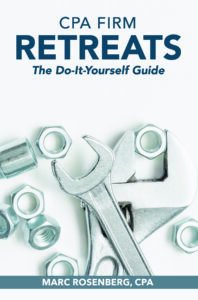Partner Retreats Can Boost Your Stats
A well-planned retreat can have real impact on your firm’s performance. A $2.4M client of ours who holds annual management retreats (sole practitioner, COO and key managers) wrote with this news when reflecting on their year over year improvements:
“You would love our stats. In comparison to the prior fiscal year: 
- We shrunk our client count by 15%.
- Our total collections grew 12%.
- We worked and billed almost the exact same total # of hours.
- Our average hourly rate billed (after adjustments) increased $34, a 25% increase.
- Our average billings per client increased just over $1,000.”
There are three overarching steps in executing a retreat that can give your firm results like these:
- Plan well. What does good retreat planning look like? Try these steps.
- Clarify what topics are most critical to be covered during the retreat
- Define the specific outcomes you wish to see as a result of your time together
- Allow issues, that can be reviewed, decided or moved forward without discussion of the whole group, to progress without taking up time on your retreat agenda
- Make sure you know how you make decisions and take action as a group
- Allow your partner group to focus on the highest and best use of your time when meeting in person together
CPA Firm Retreats: The Do-It-Yourself Guide helps firms organize their retreats. Chapters include ►ground rules for participants ►alternative retreat formats ►logistics and ►how to implement retreat ideas. The book provides specific discussion questions that the facilitator can use to stimulate conversation in topics such as ►profitability ►managing staff ►mergers ►succession planning ►marketing ►partner accountability ►firm governance ►partner compensation and ►partner buyout plans.
- Stay on track. Are there decisions to be made? During your retreat, stick to your thoughtful agenda.
- Be clear about what decision needs to be made on a given topic. Is there a strategy you’re trying to form? A decision on how to compensate new partners? Whether or not to acquire another firm this year?
- Utilize the best facilitator you have available to stay on topic, on time with your agenda and get to those key decision points.
- If it’s not possible to finalize a decision, because a lack of information or new information, determine next steps before you leave the retreat.
But not everything in a retreat is a decision. Other critical partner-group functions include brainstorming ideas for a separate committee to work through after the retreat, and good old-
fashioned team-building. Don’t ignore the agenda items focused on partner relations – they are just as important, if not more, as getting to decisions.
- Execute. Who will be responsible for taking action after the retreat? This is the biggest challenge to post-retreat success. The stats cited by our client above didn’t happen without concerted effort by the partners and managers to make it happen.
- Who will be ultimately accountable to hold other partners accountable for action items and goals arising from the retreat? Typically, this is the MP, but could be a COO or another partner.
- Which individual partners, committees or other personnel will do the heavy lifting on whatever directives or decisions were made?
- How frequently will the partner group be given updates on progress? A dashboard-style presentation of initiatives and progress can make this easy to review without taking up a lot of meeting time.
If you’re planning a retreat this year, what kind of stats do you want to see on the other side?

CPA Firm Retreats: The Do-It-Yourself Guide
Many firms hire outside facilitators for their retreats. But the majority. especially those under $15M, facilitate their own. In both cases, this all-new edition serves as a complete resource guide to convening a partner retreat that leads to action.
Learn More